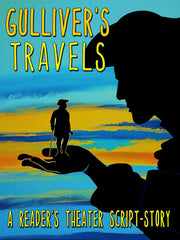
Gulliver’s Travels by Jonathan Swift is a classic of British Literature, and in spite of its many sub-par adaptations (I’m looking at you, Jack Black), it remains a timeless tale full of lessons for modern readers. So here are five reasons to teach Jonathan Swift’s Gulliver’s Travels.
- Satire is a tricky art form, and its undisputed master is Jonathan Swift. I mean, he even has an adjective named for him: “swiftian” meaning "darkly humorous." Gulliver’s Travels, written in 1726, lampoons everything from religious infighting to political parties to the monarchy itself. Swift was an ordained Irish priest who did not write for fame or money—most of his works were published anonymously—nor did he write to entertain, even though many of his works are amusing. His goal was to improve human behavior. For him, humor was a tool that could cause people to think about (and hopefully) reform their actions. In spite of being a priest, he wasn’t above throwing in a few bathroom jokes when necessary! Swift was also a wordsmith, coining words like Lilliputian and yahoo.
- The Lilliputians provide some social commentary we could still learn from today. Sometimes literary works lose their relevance almost immediately, but there’s something timeless about the lessons of Gulliver’s Travels. Gulliver’s voyage to Lilliput is easily the most famous portion—and the problems of its society the most easily recognizable. Its residents are petty and cruel—obsessed with war and social status. Swift’s criticisms of Lilliput still hit close to home. In many ways, modern people are still as “small” as Swift’s Lilliputians. Although the comical image of Gulliver staked down to the ground by his six-inch-tall captors immediately leaps to mind, the more nuanced societal criticisms are typically left out of most adaptations.
- Gulliver’s voyage to Lilliput is just one leg of four in his journey. Lilliput is just one of four voyages that Gulliver undertakes in the novel. He washes up in four fantastical lands, each flawed in some way. Swift sets up interesting contrasts with these episodes. In Gulliver’s second journey, right after experiencing the tiny land of Lilliput, it is Gulliver who is diminutive–about the size of an insect. The giants in this land (the Brobdingnagians) are not without their own “shortcomings,” but they view Gulliver (and consequently our entire race) as barbaric and cruel. When Gulliver attempts to defend mankind by citing our long history, the giants respond by calling humans, the “most pernicious race of odious little vermin that nature ever suffered to crawl upon the surface of the earth.” Ouch!
- Swift is the same guy who suggested poor people should eat their babies. Okay, he did, but he didn’t mean it. Swift’s satirical pamphlet “A Modest Proposal,” published in 1729, suggests the way to end widespread hunger and starvation among the Irish is for them to eat their own children. This tongue-in-cheek suggestion, aimed squarely at those who turned a blind eye toward the Irish plight, scandalized readers who took his suggestion at face value. Such is the danger of satire! Some get the joke. Others don’t, but either way, they’re angry.
- Gulliver’s Travels has an amazing parallel in Dr. Seuss’s The Butter Battle Book. The master of childhood rhymes takes on the Cold War in this 1984 book, The Butter Battle Book, wherein he satirizes the arms race between the United States and the Soviet Union. Just as the Lilliputians and Blefuscudians argue over the correct way to eat an egg, in The Butter Battle Book, the Zooks and Yooks argue over the correct way to butter their bread. Their conflict escalates with both sides developing more deadly weapons until they each have an egg-sized mega-bomb. Seuss’s grim warning ends with these lines, “Who's going to drop it? Will you? Or will he?”/"Be patient," said Grandpa. "We'll see. We will see…" Pretty dark for a kids’ book! But once again, it’s satire at work–trying to change the minds and hearts of its readers.
Want to teach Gulliver’s Travels? Our website offers a Reader’s Theater script-story version of Gulliver’s voyage to Lilliput, the most famous part of the story. Click here to find out more!
We also have a free handout detailing Gulliver’s second voyage to the land of the giants. That handout is here: Gulliver's Further Travels Handout
I also strongly recommend reading The Butter Battle Book to your students to help them understand how satire works. Note: This post contains affiliate links.


